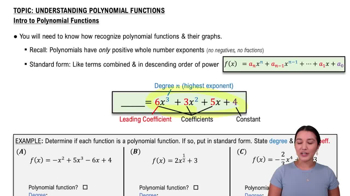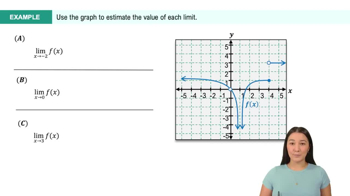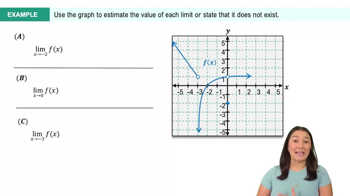Table of contents
- 0. Functions7h 52m
- Introduction to Functions16m
- Piecewise Functions10m
- Properties of Functions9m
- Common Functions1h 8m
- Transformations5m
- Combining Functions27m
- Exponent rules32m
- Exponential Functions28m
- Logarithmic Functions24m
- Properties of Logarithms34m
- Exponential & Logarithmic Equations35m
- Introduction to Trigonometric Functions38m
- Graphs of Trigonometric Functions44m
- Trigonometric Identities47m
- Inverse Trigonometric Functions48m
- 1. Limits and Continuity2h 2m
- 2. Intro to Derivatives1h 33m
- 3. Techniques of Differentiation3h 18m
- 4. Applications of Derivatives2h 38m
- 5. Graphical Applications of Derivatives6h 2m
- 6. Derivatives of Inverse, Exponential, & Logarithmic Functions2h 37m
- 7. Antiderivatives & Indefinite Integrals1h 26m
1. Limits and Continuity
Introduction to Limits
Problem 2.7.50
Textbook Question
Let f(x) =x^2−2x+3.
a. For ε=0.25, find the largest value of δ>0 satisfying the statement
|f(x)−2|<ε whenever 0<|x−1|<δ.
 Verified step by step guidance
Verified step by step guidance1
Step 1: Start by understanding the problem. We need to find the largest value of \( \delta > 0 \) such that \( |f(x) - 2| < \varepsilon \) whenever \( 0 < |x - 1| < \delta \). Here, \( f(x) = x^2 - 2x + 3 \) and \( \varepsilon = 0.25 \).
Step 2: Substitute \( f(x) = x^2 - 2x + 3 \) into the inequality \( |f(x) - 2| < 0.25 \). This gives us \( |x^2 - 2x + 3 - 2| < 0.25 \), which simplifies to \( |x^2 - 2x + 1| < 0.25 \).
Step 3: Recognize that \( x^2 - 2x + 1 \) can be rewritten as \( (x - 1)^2 \). Therefore, the inequality becomes \( |(x - 1)^2| < 0.25 \).
Step 4: Since \( |(x - 1)^2| = (x - 1)^2 \) (as squares are always non-negative), we have \( (x - 1)^2 < 0.25 \). Take the square root of both sides to get \( |x - 1| < \sqrt{0.25} \).
Step 5: Calculate \( \sqrt{0.25} \), which is 0.5. Therefore, \( \delta \) can be any value less than or equal to 0.5. The largest value of \( \delta \) satisfying the condition is \( \delta = 0.5 \).
Recommended similar problem, with video answer:
 Verified Solution
Verified SolutionThis video solution was recommended by our tutors as helpful for the problem above
Video duration:
3mPlay a video:
Was this helpful?
Key Concepts
Here are the essential concepts you must grasp in order to answer the question correctly.
Limit Definition
The limit definition in calculus describes how a function behaves as it approaches a certain point. In this context, we are interested in the behavior of f(x) as x approaches 1. The statement |f(x)−2|<ε indicates that we want the function's value to be within ε of 2, which is the limit we are examining.
Recommended video:

One-Sided Limits
Epsilon-Delta Definition of Limit
The epsilon-delta definition formalizes the concept of limits in calculus. It states that for every ε>0, there exists a δ>0 such that if |x−c|<δ, then |f(x)−L|<ε. In this problem, c is 1 and L is 2, meaning we need to find a δ that ensures the function's output remains close to 2 when x is near 1.
Recommended video:

One-Sided Limits
Quadratic Functions
Quadratic functions are polynomial functions of the form f(x) = ax^2 + bx + c. They have a parabolic shape and can be analyzed using their vertex, axis of symmetry, and roots. In this case, f(x) = x^2 - 2x + 3 is a quadratic function, and understanding its graph helps in determining how it behaves around the point x=1.
Recommended video:

Introduction to Polynomial Functions

 6:47m
6:47mWatch next
Master Finding Limits Numerically and Graphically with a bite sized video explanation from Callie
Start learning




